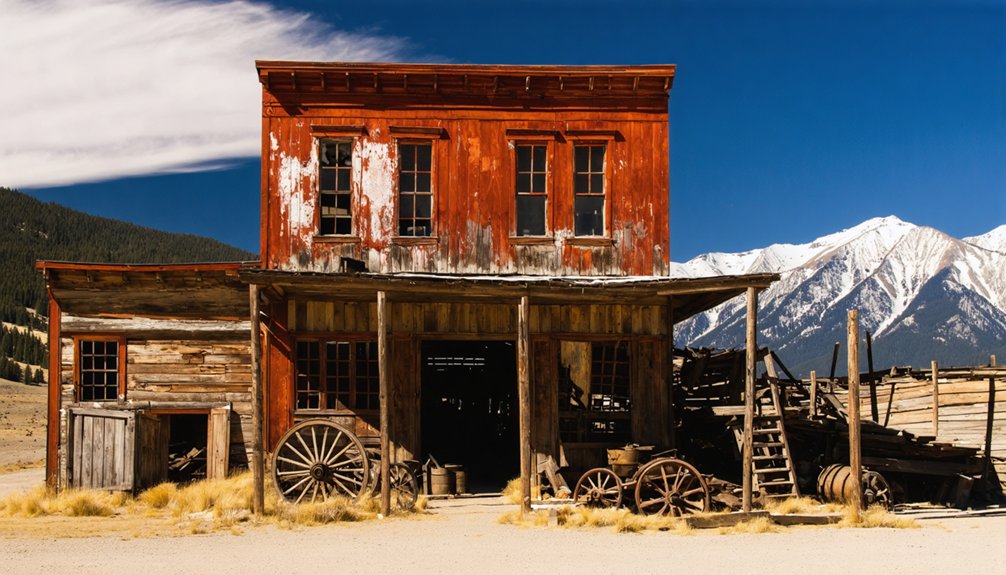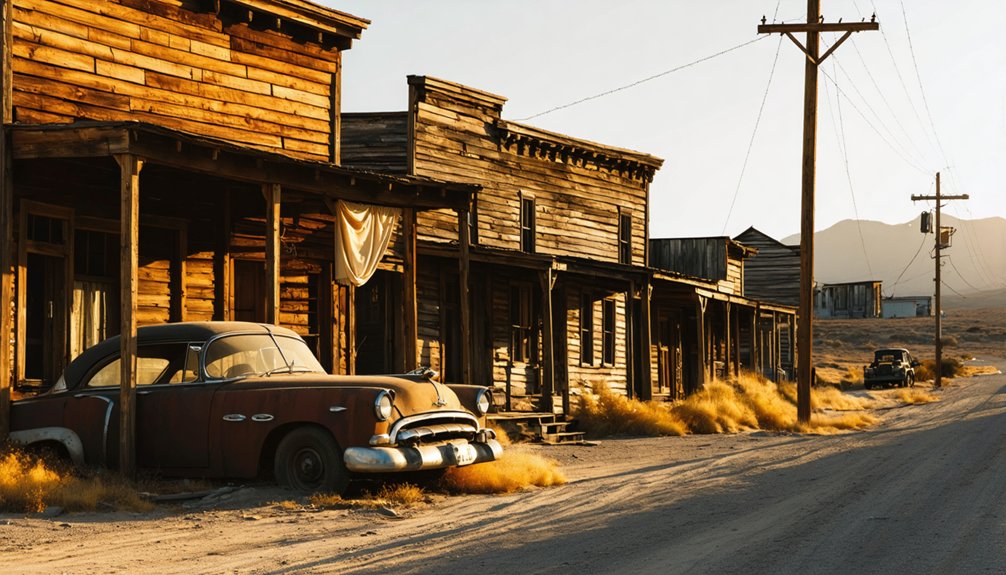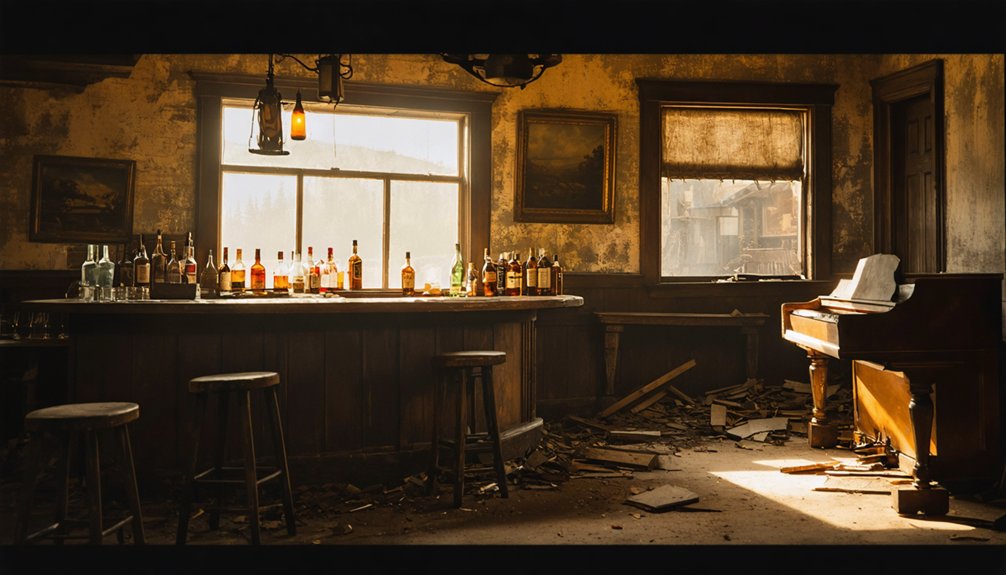You’ll find Wyoming’s ghost towns scattered across the windswept frontier, each telling haunting tales of boom-and-bust cycles. South Pass City’s 40 original structures whisper stories of gold fever, while Carbon’s abandoned cemetery marks tragic mining disasters. Don’t miss Benton’s blood-soaked grounds, where 100 gunfighters met their end, or Atlantic City’s rusting mine equipment. These five ghost towns, plus five more equally fascinating sites, hold secrets that’ll make your spine tingle.
Key Takeaways
- South Pass City’s 40 original structures from the 1860s gold rush include restored miners’ quarters that reveal harsh frontier living conditions.
- Benton’s dark history of over 100 gunfight fatalities makes it one of Wyoming’s most notoriously violent ghost towns.
- Carbon’s abandoned cemetery, with its weathered headstones and mining tragedy stories, creates an especially haunting atmosphere.
- Piedmont’s massive stone kilns, linked to Butch Cassidy, stand as eerie monuments among crumbling buildings and forgotten settlements.
- Atlantic City’s gold mining ruins and century-old structures house just 50 year-round residents among its historic ghost town remains.
The Haunting Remains of South Pass City
When gold was discovered in Wyoming’s Wind River Mountains in 1867, South Pass City sprang to life almost overnight.
Within a year, you’d have found over 250 buildings lining a bustling half-mile main street, with 1,000 souls trying their luck at striking it rich.
Today, you’ll walk among haunted structures that whisper tales of boom and bust. The admission fee varies with out-of-state visitors paying $8 and Wyoming residents $4.
Shadowy figures drift through weathered walls, as empty saloons and abandoned mines echo stories of forgotten dreams.
The mining echoes still resonate through the Carissa Mine, where prospectors once toiled.
While the railroad’s bypass and costly gold extraction spelled the town’s doom by 1872, what remains is one of the West’s most authentic ghost towns. The town attracts visitors during its summer season only, operating from mid-May through September.
You can explore 23 restored buildings, including Wyoming’s oldest jail, and discover thousands of artifacts that tell the story of frontier life, women’s rights, and the rugged spirit of the American West.
Carbon’s Fiery Demise and Lost Legacy
Along the old Union Pacific Railroad line between Laramie and Rawlins, you’ll find the haunting remnants of Carbon, Wyoming – a town that literally lived up to its name.
You won’t see much today except crumbling foundations and the weathered cemetery, but back in 1868, this coal-mining hub bustled with nearly 1,000 souls. Life wasn’t easy – miners faced deadly accidents, disease ran rampant, and water had to be hauled in by train. Union Pacific Railroad established the town to supply fuel for their steam locomotives.
The town’s fate was sealed on June 27, 1890, when a knocked-over kerosene lamp sparked an inferno that devoured 20 buildings. Any hope of Carbon’s rebirth went up in smoke, and by 1902, the last mine closed.
Now, these historical remnants serve as silent sentinels, reminding you of Wyoming’s rugged mining heritage and the boom-and-bust cycle that shaped the West. Today, visitors can learn about this fascinating chapter of history through the Hanna Museum where artifacts and detailed records of Carbon’s past are preserved.
Benton: The 90-Day Wonder That Vanished
Benton’s brief existence was marked by staggering lawlessness and crime, with over 100 men dying in gunfights.
The town’s shanty tents and makeshift buildings housed brothels, gambling dens, and the infamous “Big Tent.” A lack of nearby water sources ultimately doomed the town despite its peak population of 3,000 residents.
Like many ghost town sites across Wyoming, Benton stands as a living record of the state’s dramatic boom-and-bust industrial past.
Atlantic City’s Golden Dreams Gone Cold
You’ll find rusting mining equipment scattered across Atlantic City’s landscape today, serving as silent witnesses to Wyoming’s ambitious gold rush days.
The local mining industry yielded an impressive two million dollars in gold during its first five productive years.
Nestled near the Wind River Mountains, this semi-ghost town still harbors about 50 year-round residents who live among the weathered log cabins and historic hotel ruins.
Walking these quiet streets, you’ll spot the old Gratrix Cabin and French Quarter remains, where once-bustling crowds of 2,000 miners dreamed of striking it rich in the nearby quartz veins.
Visitors can now enjoy refreshments at the historic Miners Grubstake & Dredge Saloon while reflecting on the town’s golden past.
Mining Equipment Still Stands
Standing as silent sentinels to Atlantic City’s golden age, the rusted remnants of mining equipment dot the Wyoming landscape, telling tales of boom-and-bust cycles that defined this frontier town.
You’ll find Gustave Granier’s ambitious Rock Creek ditch system, though its steep slope proved too aggressive for effective gold recovery. The massive E.T. Fisher dredge that pulled $700,000 in gold from local streams still marks the shift from manual to mechanical mining.
Just three miles northwest, you can spot the abandoned U.S. Steel operation where iron ore mining kept the town alive until 1982. The Dexter Mill’s stamps, weighing 1,050 pounds each, remain as testament to the town’s industrial aspirations.
These mining remnants, from simple sluices to industrial machinery, showcase the historical significance of Atlantic City’s evolution from hand panning to large-scale operations. They’re weathered witnesses to the town’s determined spirit and resourceful past. Today, visitors can explore these historic sites along with the preserved St. Andrews Episcopal Church from 1912.
Wind River’s Hidden Treasure
Deep in Wyoming’s Wind River Range lies the story of Atlantic City’s meteoric rise and gradual fade into frontier memory.
You’ll find hidden treasures in this remote outpost where gold fever once gripped hundreds of fortune seekers. What started as a promising strike in 1868 quickly drew 500 souls, but the buried secrets of these hills proved elusive. By 1870, the population had already dwindled to 325 as the precious metal grew scarce.
- You can still walk the weathered boardwalks where prospectors once dreamed of striking it rich
- Original log cabins stand as silent sentinels to boom-time ambitions
- The historic Gratrix Cabin whispers tales from 1842
- Wind-swept streets echo with memories of failed revival attempts spanning decades
Today, fewer than 60 hardy souls keep watch over this monument to frontier perseverance.
Life Among Empty Buildings
While the howling Wyoming wind sweeps through Atlantic City’s abandoned streets, time stands frozen among the weathered structures that once bustled with gold-hungry prospectors.
You’ll find yourself walking past original log cabins and rusted mining equipment, each telling stories of frontier dreams and devastating busts. These abandoned structures whisper tales of international miners who braved harsh winters and deadly avalanches in pursuit of golden fortunes.
Today, you’re free to explore this authentic slice of the Old West, where cultural reflections of the past linger in every creaking floorboard and empty doorway.
During seasonal events like Gold Rush Days, you can step back into the 1860s, when Atlantic City’s streets teemed with life.
Now, nature slowly reclaims what man once built, creating an eerie reflection of frontier ambition.
The Dangerous Depths of Rudefeha
If you’re planning to explore Rudefeha’s abandoned mines today, you’ll need to watch your step around those unfilled shafts that still dot the landscape – deadly reminders of the town’s copper mining heyday.
While snowstorms caused several shaft house roofs to collapse over the years, the most chilling tale involves miners who met their fate in an avalanche near Head-of-Cow-Creek, their bodies later found with mining gear still intact.
You’d be wise to heed the warnings about these dangerous depths, as the abandoned mine shafts continue to pose serious hazards to modern-day ghost town visitors.
Deadly Mine Shaft Hazards
Beneath the weathered surface of Rudefeha’s ghost town lies a treacherous network of unsealed mine shafts that’ll make your blood run cold.
Back when mining regulations were practically non-existent, these dangerous pits claimed many lives, including George Ferris in 1900.
You won’t find any shaft safety measures here – just flooded tunnels and unstable ground that could give way beneath your feet at any moment.
- Dark, water-filled shafts hide deadly depths that’ve swallowed both people and wildlife
- Rotting support beams creak ominously in the mountain winds, ready to collapse
- Toxic mine drainage seeps into local streams, leaving behind an invisible killer
- Decaying buildings and equipment could come crashing down without warning, especially after heavy snow
Ghost Stories And Legends
After the last miners abandoned Rudefeha’s copper-rich tunnels in 1908, they left behind more than just empty shafts and crumbling buildings – they created the perfect backdrop for Wyoming’s most bone-chilling ghost stories.
If you visit the stone ruins today, you’ll understand why locals won’t go near after dark. Paranormal investigators have captured unexplainable electromagnetic spikes, while visitors report hearing miners’ cries echoing from deep within the earth.
You might catch disembodied voices calling out orders or the desperate pleas of men trapped in long-ago cave-ins. Rudefeha legends tell of soldiers and settlers who never truly departed, their spirits still wandering the empty hills of Sweetwater County.
Even skeptics admit there’s something unsettling about the site, where history and haunting have become eternally intertwined.
Piedmont’s Silent Stone Sentinels

Standing like ancient guardians on Wyoming’s windswept plains, three massive stone kilns mark what remains of the once-bustling town of Piedmont.
You’ll find these beehive-shaped structures, built in 1869, towering 25 feet high – evidence of Piedmont’s essential role in charcoal production for the Union Pacific Railroad.
These kilns transformed timber from the Uinta Mountains into fuel that powered the iron horses of the American frontier, until a new mountain tunnel left the town behind.
- The eerie silence that surrounds these weathered sentinels speaks of dreams abandoned.
- Worn stone walls hold stories of frontier determination and eventual defeat.
- Each 30-foot diameter kiln stands as a monument to the untamed spirit of the Old West.
- You’ll feel the weight of history in this remote outpost where time stands still.
Tales From Wyoming’s Abandoned Mining Camps
You’ll find Wyoming’s abandoned mining camps tell stark tales of fortune’s wild swings, from the overnight shutdowns of coal towns like Gebo to the recurring booms and busts of gold settlements like Miners Delight.
Life underground shaped these communities, where immigrant miners carved out both precious metals and tight-knit societies in company towns scattered across the state’s rugged landscape.
Today, their weathered remnants – preserved cabins, mine shafts, and stone ruins – stand as a testament to the thousands who once called these places home during Wyoming’s mineral rushes.
Mining’s Boom and Bust
When Wyoming’s mineral riches beckoned in the late 1800s, fortune-seekers rushed to establish mining camps that would soon transform into bustling towns.
You’ll find Wyoming’s mining heritage etched into places like South Pass City, where 2,000 miners once chased golden dreams, and Rock Springs, where coal fueled prosperity until the 1950s.
These towns rode waves of economic fluctuations that ultimately left them empty.
- You can still walk among the weathered foundations where entire families once built their lives in company towns like Winton and Reliance.
- You’ll discover how miners’ homes were sold for pennies and hauled away when the mines went quiet.
- You’re walking the same paths where $5 million in gold ore was extracted at Miners Delight.
- You’re witnessing the raw freedom and harsh reality of frontier life in these abandoned settlements.
Life Underground and Above
Deep beneath Wyoming’s rugged terrain, miners once carved out their existence in pitch-black tunnels while their families struggled to build communities above ground.
You’d find them working 12-hour shifts, battling underground dangers like cave-ins, toxic gases, and unstable rock faces, armed with nothing but lanterns and basic tools.
Their families faced their own battles topside, where extreme weather, isolation, and limited resources tested their camp resilience daily.
Life revolved around company stores, shared water wells, and makeshift schools.
You wouldn’t find much law enforcement around – folks mostly settled their own disputes.
Despite the harsh conditions, these mining communities forged tight bonds through church gatherings, community events, and shared hardships.
Their legacy lives on in the weathered ruins and compelling stories they left behind.
Preserved Memories in Stone
Though the winds of time have scattered Wyoming’s mining communities, their stories stand frozen in stone across the state’s rugged landscape.
You’ll find preserved architecture in South Pass City’s original saloons and the carefully maintained cabins of Miners Delight, where historical artifacts tell tales of frontier dreams.
These remnants paint a picture of Wyoming’s wild mining days, from the copper boom towns of Battle and Dillon to Reliance’s iconic coal camp legacy.
- Walk through crumbling foundations where entire towns once hummed with life
- Touch weathered walls that sheltered generations of hard-working miners
- Explore restored buildings where gold rush fever once gripped prospectors’ hearts
- Stand in silent tribute where determined souls carved their fortunes from Wyoming’s earth
Forgotten Frontiers: Lost Towns of the West
Along the windswept prairies and rugged mountains of Wyoming, you’ll find the haunting remains of once-bustling frontier towns that time has nearly forgotten. Carbon, a symbol of the untamed West, stands as one of these forgotten settlements.
You can still walk among the scattered foundations where 1,000 souls once called home, before mining tragedies, Indian raids, and devastating fires forced them to abandon their dreams. The 1890 inferno that devoured most of Carbon’s structures left only whispers of its coal-mining heyday.
Today, as you wander through its weathered cemetery, you’ll witness the harsh reality these pioneers faced. The town’s demise, hastened by mine closures and the railroad’s departure, echoes the boom-and-bust cycle that defined Wyoming’s frontier spirit.
Ghosts of the Railroad Boom

When the Union Pacific Railroad blazed through Wyoming’s untamed frontier in the 1860s, it scattered temporary towns like seeds across the landscape.
You’ll find railroad ghosts in places like Bryan, Carbon, and Bear River City, where transient echoes of saloons and gunfights still linger in the wind.
These towns burst to life with immigrant workers, gamblers, and fortune-seekers, only to vanish when the railroad changed course or the work dried up.
- Stand in Bear River City’s ruins, where only foundations whisper tales of its wild heyday
- Walk Carbon’s abandoned cemetery, where weathered headstones tell stories of frontier dreams
- Explore Benton’s remnants, where over 100 souls met their end in blazing gunfights
- Discover Piedmont’s crumbling buildings, abandoned when the iron horse chose a different path
Preserved Pieces of Wyoming’s Wild Past
While many railroad towns faded into prairie dust, several remarkable ghost towns stand as time capsules of Wyoming’s frontier spirit.
You’ll find historical architecture preserved in South Pass City, where 40 original structures tell tales of the 1860s gold rush. In Atlantic City, a century of mining heritage lives on through the iconic Mercantile and scattered log cabins.
Head to Piedmont to marvel at the massive charcoal kilns where Butch Cassidy once roamed, or explore Carbon’s remnants, where coal once fueled the Union Pacific’s mighty locomotives.
Each site offers you a raw glimpse into frontier life – from South Pass City’s crude miners’ quarters to Atlantic City’s rusted equipment. These aren’t just abandoned towns; they’re gateways to Wyoming’s untamed past, where fortune seekers carved their destiny from the wilderness.
Frequently Asked Questions
Are There Any Reported Paranormal Activities in Wyoming’s Ghost Towns?
You’ll find plenty of ghost sightings in Sweetwater County’s ghost towns, where paranormal investigations regularly document EVPs, mysterious orbs, and unsettling voices from old mines and abandoned buildings.
Can Visitors Legally Collect Artifacts From These Abandoned Mining Sites?
You can’t legally remove artifacts from Wyoming’s ghost towns – mining regulations strictly protect these sites. If you’re caught collecting, you’ll face hefty fines. Focus on photos and artifact preservation instead.
What’s the Best Season to Visit Wyoming’s Ghost Towns?
You’ll find the best time’s late spring through early fall, when you’re free from snow hazards and seasonal changes won’t catch you off guard. Plus, ghost town festivals and amenities are in full swing.
Do Any Ghost Towns Still Have Permanent Residents Today?
Believe it or not, you’ll find current residents keeping ghost town history alive. South Pass City has six inhabitants, Superior maintains 300 people, and Jeffrey City holds a handful of dedicated souls.
Are Guided Tours Available at Any of These Historic Sites?
You’ll find guided experiences at several sites, including Kirwin Ghost Town Tours, South Pass City during Gold Rush Days, and Grand Encampment Museum, where knowledgeable guides offer fascinating historical insights.
References
- https://www.wyomingcarboncounty.com/blog/123-5-ghost-towns-to-explore
- https://travelwyoming.com/blog/stories/post/wy-hidden-histories-pioneers-ghost-towns/
- https://sites.rootsweb.com/~wytttp/ghosttowns.htm
- https://travelwyoming.com/blog/stories/post/5-wyoming-ghost-towns-you-need-to-explore/
- https://www.youtube.com/watch?v=GEoxbcwf8Ks
- https://travelwyoming.com/?search=wyoming%20ghost%20towns&view=List
- https://www.onlyinyourstate.com/experiences/wyoming/creepy-ghost-towns-in-wy
- https://en.wikipedia.org/wiki/List_of_ghost_towns_in_Wyoming
- https://mycountry955.com/would-you-stay-in-any-of-wyomings-great-ghost-towns/
- https://www.ghosttowns.com/states/wy/wy.html



